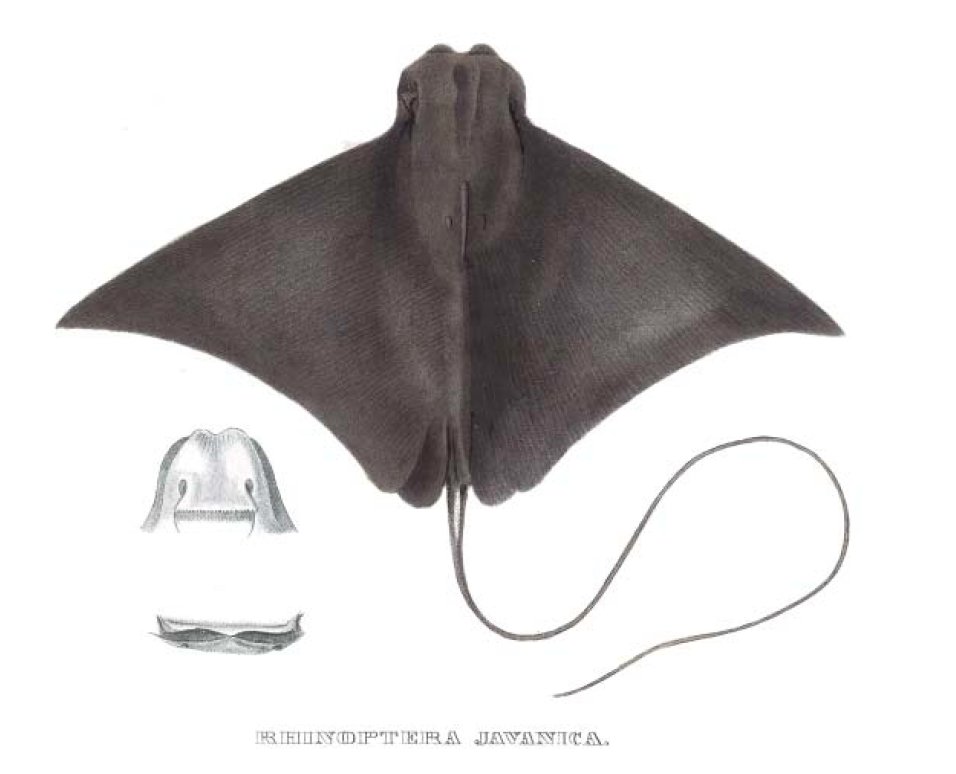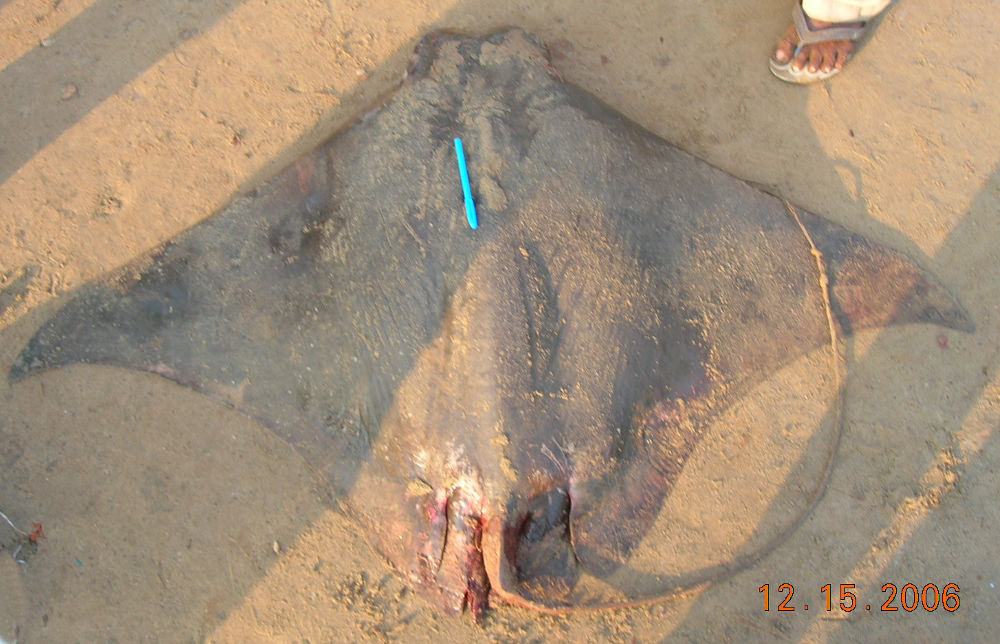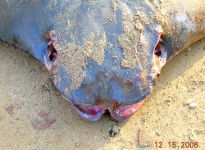Rhinoptera javanica
Müller & Henle, 1841
Javanese cownose ray
Classification: Elasmobranchii Myliobatiformes Rhinopteridae
Reference of the original description
Systematische Beschreibung der Plagiostomen. Berlin, Veit, pp. 1–200
Systematische Beschreibung der Plagiostomen. Berlin, Veit, pp. 1–200
Image of the original description

Rhinoptera javanica Müller & Henle, 1841

Rhinoptera javanica Müller & Henle, 1841
Synonyms / new combinations and misspellings
Rhinoptera adspersa
Rhinoptera adspersa
Types
Rhinoptera javanica
Syntype: MNHN: 3478; MNHN: 2450; RMNH: ?
Rhinoptera adspersa
Holotype: MNHN: 3482;
Rhinoptera javanica
Syntype: MNHN: 3478; MNHN: 2450; RMNH: ?
Rhinoptera adspersa
Holotype: MNHN: 3482;
Description :
Citation: Rhinoptera javanica Müller & Henle, 1841: In: Database of modern sharks, rays and chimaeras, www.shark-references.com, World Wide Web electronic publication, Version 05/2025
Please send your images of "Rhinoptera javanica" to info@shark-references.com

Rhinoptera javanica Müller & Henle, 1841, Gautami Godavari Estuary, Kakinada Bay , on East Coast of India © Dr. Padmavathi Devarapalli, FishBase Collaborator 1675, Kakinada-533003, Andhra Pradesh, INDIA

Rhinoptera javanica Müller & Henle, 1841, Gautami Godavari Estuary, Kakinada Bay , on East Coast of India © Dr. Padmavathi Devarapalli, FishBase Collaborator 1675, Kakinada-533003, Andhra Pradesh, INDIA
Common names
 Mourine javanaise,
Mourine javanaise,  Cownose ray,
Cownose ray,  Eagle ray,
Eagle ray,  Flapnose ray,
Flapnose ray,  Flapray,
Flapray,  Javanese cow ray,
Javanese cow ray,  Javanese cow-nose ray,
Javanese cow-nose ray,  Javanese cownose ray,
Javanese cownose ray,  Javanese cowray
Javanese cowray
 Mourine javanaise,
Mourine javanaise,  Cownose ray,
Cownose ray,  Eagle ray,
Eagle ray,  Flapnose ray,
Flapnose ray,  Flapray,
Flapray,  Javanese cow ray,
Javanese cow ray,  Javanese cow-nose ray,
Javanese cow-nose ray,  Javanese cownose ray,
Javanese cownose ray,  Javanese cowray
Javanese cowray
Short Description
Double-lobed snout and indented forehead; jaws usually with 7 rows of plate-like teeth; no caudal fin [536]. Brown above, white below [536].
Double-lobed snout and indented forehead; jaws usually with 7 rows of plate-like teeth; no caudal fin [536]. Brown above, white below [536].
Distribution
Indo-West Pacific: off Durban, South Africa and ranging north possibly to India, Thailand, Indonesia, and southern China. Also in Okinawa, Ryukyu Islands (Ref. 637). Possibly Australia (Ref. 9862). Source: www.gbif.org
Indo-West Pacific: off Durban, South Africa and ranging north possibly to India, Thailand, Indonesia, and southern China. Also in Okinawa, Ryukyu Islands (Ref. 637). Possibly Australia (Ref. 9862). Source: www.gbif.org
Human uses
fisheries: commercial; gamefish: yes
fisheries: commercial; gamefish: yes
Biology
Males court by nipping the female"quot;s dorsum. Mating pair orient in a venter to venter position, and the male inserts one or both claspers. The pair usually rests on the substrate, with the female on top of the male. Mating lasts about 30 seconds [1658] to 1 minute (Ref. 49562). Exhibit ovoviparity (aplacental viviparity), with embryos feeding initially on yolk, then receiving additional nourishment from the mother by indirect absorption of uterine fluid enriched with mucus, fat or protein through specialised structures [733]. Size at birth ~60 cm WD. One large pregnant female (~130 cm WD) contained a single late-term embryo 61 cm WD [2539]. Found in bays, estuaries, and near coral reefs [1658], over sand and mud bottoms (Ref. 9710). Large schools with up to 500 individuals have been reported [1658]. Feeds on clams, oysters and crustaceans[17641]
Males court by nipping the female"quot;s dorsum. Mating pair orient in a venter to venter position, and the male inserts one or both claspers. The pair usually rests on the substrate, with the female on top of the male. Mating lasts about 30 seconds [1658] to 1 minute (Ref. 49562). Exhibit ovoviparity (aplacental viviparity), with embryos feeding initially on yolk, then receiving additional nourishment from the mother by indirect absorption of uterine fluid enriched with mucus, fat or protein through specialised structures [733]. Size at birth ~60 cm WD. One large pregnant female (~130 cm WD) contained a single late-term embryo 61 cm WD [2539]. Found in bays, estuaries, and near coral reefs [1658], over sand and mud bottoms (Ref. 9710). Large schools with up to 500 individuals have been reported [1658]. Feeds on clams, oysters and crustaceans[17641]
Size / Weight / Age
150 cm WD (male/unsexed; (Ref. 9862)); max. published weight: 4,500 g (Ref. 3965)
150 cm WD (male/unsexed; (Ref. 9862)); max. published weight: 4,500 g (Ref. 3965)
Habitat
reef-associated; brackish; marine
reef-associated; brackish; marine
Remarks
shark-references Species-ID=6065;
shark-references Species-ID=6065;
Parasites (arranged by Jürgen Pollerspöck)
Myxosporea
Monogenea
Cestoda
Isopoda
Myxosporea
- Chloromyxum acuminatum Lisnerova, Martinek, Alama-Bermejo, Bouberlova, Schaeffner, Nkabi, Holzer & Bartosova-Sojkova, 2022 [31228]
Monogenea
Cestoda
- Eniochobothrium gracile Shipley & Hornell, 1906 [16338]
- Eniochobothrium qatarense Al Kawari, Saoud & Wanas, 1994 [16170]
- Halysioncum rhinoptera (Shipley & Hornell, 1906) [16430] [19536]
- Phyllobothrium rhinoptera Vijayalakshmi & Sarada, 1996 [8187]
- Rhinoptericola butlerae (Beveridge & Campbell, 1988) [30611]
- Tetrarhynchobothrium unionifactor (Shipley & Hornell, 1904) [16255] [16112]
Isopoda
- Gnathia maculosa Ota & Hirose, 2009 [21224] [22155]
- Gnathia rufescens Ota, 2015 [22155]
- Gnathia teruyukiae Ota, 2011 [22155]
- Gnathia trimaculata Coetzee, Smit, Grutter & Davies, 2009 [21224] [17188] [22155]
















